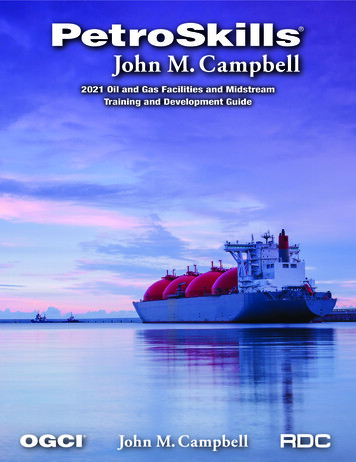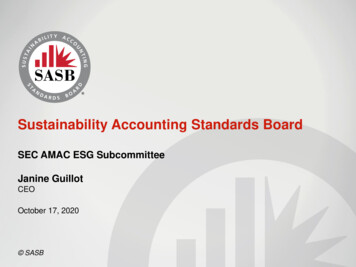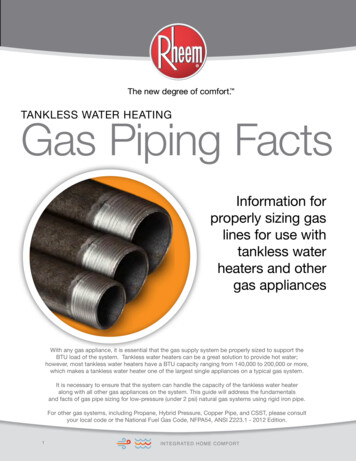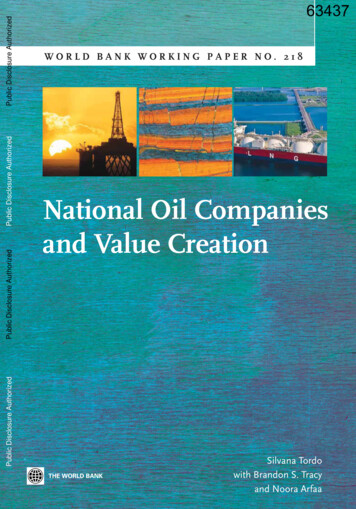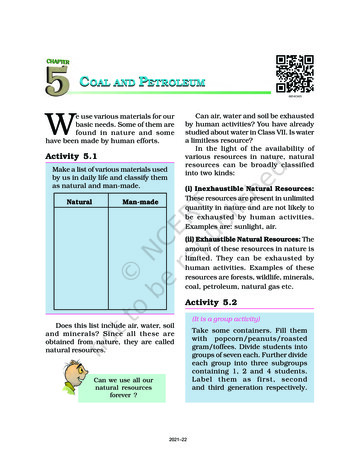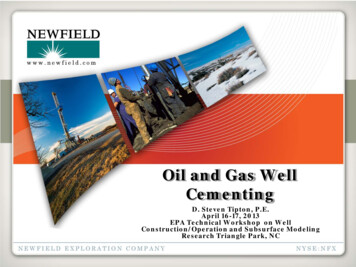
Transcription
Oil and Gas WellCementingD. Steven Tipton, P.E.April 16-17, 2013EPA Technical Workshop on WellConstruction/Operation and Subsurface ModelingResearch Triangle Park, NC
Protecting Water is EssentialFor Everyone
Cementing Cementing is one of the most critical steps in the drillingand completion of oil or gas wells Well cementing technology is the application of manyscientific and engineering disciplines
Primary Cementing Process of placing cement in the annulus betweenthe casing and the wellbore Objectives: Provide Hydraulic Seal Create Zonal Isolation Protect Useable Water Provide Structural Support for Casing Protect Casing from Corrosion Isolate Casing Seat for Subsequent Drilling
Primary Cementing Starts with a Plan The plan should take well from drilling throughplugging The well plan includes: Wellbore Environment Well Type Casing and Cement Program Mud System Type of Completion
Effective Primary Cementing Good drilling practices and mud properties Casing movement while cementing Centralization of the casing Optimal borehole pipe clearance Use of spacers and mud flushes
Fundamentals of Cement Placement Casing Hardware Float EquipmentCentralizersWiper PlugsMulti-stage tools Hole conditioning and mud properties Mud RheologyGel StrengthFluid LossCirculation RateFilter cake removal Casing movement while cementing Rotation Reciprocation Use of spacers and mud flushes
Variables Affecting Zonal IsolationGEOMECHANICS:In-situ stresses, change instresses along borehole,change in stresses in cementand pipeBOREHOLE:Size, shape, uniformityCEMENTINGPROCESS:Displacement design,job execution, cementvolumes, cementmaterial propertiesCHEMISTRY:Corrosion and chemicalresistance of casing and cementGEOLOGY/GEOCHEMISTRY:Formation type, structure,formation fluid chemistryBOREHOLE STABILITY:Lost circulation, flows, structuralintegrity and characteristics offormationsPRESSURE ANDTEMPERATURECHANGES/CYCLINGOver the life of the wellMATERIAL PROPERTIES:Cement, relationships betweenpipe-cement-formation
Benefits of Pipe Rotation During Cementing3-D Computer Modeling of Displacement of Mud by Spacer and CementCourtesy ofNo Pipe Rotation20 RPM Pipe Rotation
Current Well Design – Deep Intermediate CasingFORM. / CSGTVD50'MD50'Shallow Shales13 3/8" ShoeCASING PROFILE HOLE SIZE20"17 1/2'1,500'6,861'9 5/8" TOC7,500'Deese (GDS)8,789'5 1/2" TOC10,800'11,459'11,838'11,900'Primrose (Morrow )Springer Shale9 5/8" ShoeBlack MarkerSpringer 2 (false caney)Springer 3 (false caney)KOPCaneyWoodfordEOBMUD INFO100% ExcessCmt to Surf.NOTESVertical 2º13 3/8", J-5554.5#1,500'12 1/4"Base/Heebner Shale (GDS)CSG SPECS7,500'CIT 300 PSI / 30 min11.0 PPG FITTOC 1,000'above ,400'8 3/4"14,400'14,414'14,731'14,901'15,310'9 5/8", L-8040#CIT 1500 PSI / 30 min12.5 PPG FITSwell packer @ 7,000'TOC 1,000 into9 5/8" CsgBuild: 14-16º/10023#, P-110, BlueLOL:4,950TD:TD TVD:20,26014,721
Newfield Mid-Continent OperationsDrilling Mud circulated until it has therequired properties Casing is Centralized Casing is reciprocated rotatedduring cementing On the production casing aswell packer is run and setinside intermediate casingstring Using TergoVis! EfficiencyFluid
Newfield Mid-Continent OperationsCompletions Test annulus between theproduction casing andintermediate casing forpressure Annular pressure monitoredduring hydraulic fracturetreatment Production casing pressuretested to 80% of yield beforepumping hydraulic fracturetreatment Production casing attached toautomatic shut downs andrelief lines while pumping job
Summary Zonal isolation for each well must be designed and constructedwith regard to its unique geological environment. There is no single fit-for-purpose design, well construction, orbarrier verification process that is right for all wells. The barrier system that protects usable water includes surfacecasing and cement. Verification of the barriers is typically accomplished by bothpressure testing (direct measurements of casing and shoecement) and by an operational evaluation (cement placementbehind pipe). There is no direct measurement available to verify a cementbarrier behind casing at this time.
Conclusions Casing has been cementedin wells for more than 100years Cementing best practiceshave been known for morethan 60 years. Best practices have to beused by everyone to Protect the environmentand community Obtain maximum valuefrom your wells
Questions!?!?!
Oil and Gas Well Cementing Author: US EPA, ORD Subject: D. Steven Tipton, Newfield Exploration Company, presentation - Well Construction/Operation and Subsurface Modeling Keywords: Study of the Potential Impacts of Hydraulic Fracturing on Drinking Water Resources, April 16-17, 2013, EPA Tec


